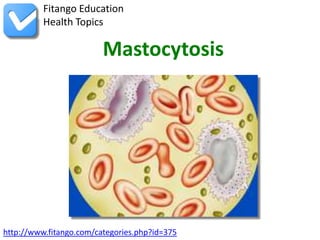Mastocytosis
•Download as PPTX, PDF•
5 likes•3,365 views
Mastocytosis is a disorder that can occur in both children and adults. It is caused by the presence of too many mast cells in your body. You can find mast cells in skin, lymph nodes, internal organs (such as the liver and spleen) and the linings of the lung, stomach, and intestine. Mast cells play an important role in helping your immune system defend these tissues from disease. Mast cells attract other key players of the immune defense system to areas of your body where they are needed by releasing chemical “alarms” such as histamine and cytokines.
Report
Share
Report
Share

Recommended
Recommended
More Related Content
What's hot
What's hot (10)
Similar to Mastocytosis
Similar to Mastocytosis (20)
Mast Cell Activation Syndrome: The Immune System Gone Wrong

Mast Cell Activation Syndrome: The Immune System Gone Wrong
Chemotherapy, Aminoglycosides, cellular mediators, Allergy (hypertension) and...

Chemotherapy, Aminoglycosides, cellular mediators, Allergy (hypertension) and...
AUTOCOIDS :HISTAMINE BRADYKININ LIPID-DERIVED AUTACOIDS: EICOSANOIDS AND PLAT...

AUTOCOIDS :HISTAMINE BRADYKININ LIPID-DERIVED AUTACOIDS: EICOSANOIDS AND PLAT...
More from fitango
More from fitango (20)
Mastocytosis
- 1. Fitango Education Health Topics Mastocytosis http://www.fitango.com/categories.php?id=375
- 2. Overview Mastocytosis is a disorder that can occur in both children and adults. It is caused by the presence of too many mast cells in your body. You can find mast cells in skin, lymph nodes, internal organs (such as the liver and spleen) and the linings of the lung, stomach, and intestine. 1
- 3. Overview Mast cells play an important role in helping your immune system defend these tissues from disease. Mast cells attract other key players of the immune defense system to areas of your body where they are needed by releasing chemical “alarms” such as histamine and cytokines. 2
- 4. Symptoms Chemicals released by mast cells cause changes in your body’s functioning that lead to typical allergic responses such as flushing, itching, abdominal cramping, and even shock. When too many mast cells are in your body, the additional chemicals can cause: -- Musculoskeletal pain 3
- 5. Symptoms -- Abdominal discomfort -- Nausea and vomiting -- Ulcers -- Diarrhea -- Itching 4
- 6. Symptoms It can also cause episodes of hypotension (very low blood pressure and faintness) or anaphylaxis (shock). 5
- 7. Diagnosis Your healthcare provider can diagnose cutaneous mastocytosis by the appearance of your skin and confirm it by finding an abnormally high number of mast cells on a skin biopsy. Your provider can diagnose systemic mastocytosis by finding an increased number of abnormal mast cells during an examination of your bone marrow. 6
- 8. Diagnosis Other tests that are important in evaluating a suspected case of mastocytosis include: Measurement of a protein (tryptase) from mast cells in your blood A search for specific genetic mutations that health experts associate with this disease. 7
- 9. Treatment Healthcare providers use several medicines to treat mastocytosis symptoms, including antihistamines (to prevent the effect of mast cell histamine--a chemical) and anticholinergics (to relieve intestinal cramping). A number of medicines treat specific symptoms of mastocytosis. -- Antihistamines frequently treat itching and other skin complaints. 8
- 10. Treatment -- Certain antihistamines work specifically against ulcers; proton pump inhibitors also relieve ulcer- like symptoms. -- Epinephrine treats symptom flares which occur with shock, referred to as "anaphylaxis. -- Two types of antihistamines treat severe flushing and low blood pressure before symptoms appear. 9
- 11. Treatment -- Steroids treat malabsorption, or impaired ability to take in nutrients. -- Cromolyn sodium may help reduce cramping in the abdomen. In cases in which mastocytosis is malignant, cancerous, or associated with a blood disorder, steroids and/or chemotherapy may be necessary. 10